Get ready to dive into the ultimate guide on how to build the most drool-worthy charcuterie boards ever. These edible masterpieces are not just your average meat platters; they’re a delightful collision of flavors, textures, and downright scrumptiousness. In this guide, you’ll learn how to select the perfect meats and cheeses to how to arrange them with finesse – by the end, you’ll be well-equipped to create your own Instagram-worthy charcuterie board.
How Much Food Do I Need on My Charcuterie Board?
Finding the perfect balance is the key to a successful charcuterie board. Remember, it’s an appetizer, not a main course. Plan for 2 to 3 slices of meat (approximately 2 to 3 ounces per person) and about 1 1/2 to 1 3/4 pounds of cheese (3 medium-size hunks) for 8-10 guests. Don’t skimp on the extras; they add flair and keep the flavors flowing!
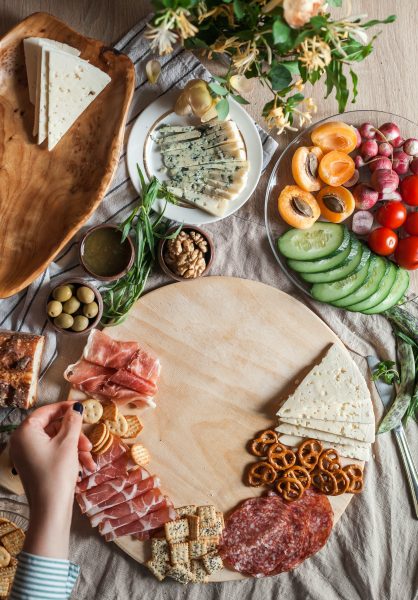
The Best Meats for a Charcuterie Board
Cured meats are the heart and soul of a charcuterie board. To create a well-rounded selection, consider including these major groups of meats:
Dry-Cured Pork: This category includes thin-sliced, fatty, and slightly salty meats like Serrano ham, prosciutto, country ham, Iberico ham, capicola, and speck. Look for meats with a pink or red hue and white fat. You can find them prepackaged or sliced fresh from the deli.
Bresaola: Similar to prosciutto, bresaola is made from beef top round, offering a deeper flavor and more toothsome texture. Look for thin slices with a rich reddish color and a texture that’s not too dry or cracked.
Salami: A versatile and varied aged sausage made from ground meat seasoned with herbs, spices, and alliums, then dried and fermented into various styles like soppressata, finocchiona, and Genoa. Smaller salamis are best served in thicker slices, while larger ones are best shaved thin. They should be vibrant in color when sliced.
Other Fun Additions: Consider adding mortadella, a tender and flavorful Italian sausage studded with pistachios, and explore meat spreads like rillettes and patés. Rillettes are meat slow-cooked in fat until they reach a spreadable consistency, while patés are finely ground meat mixed with ingredients like sauterne, truffles, and spices. ‘Nduja, a spicy Italian meat spread, pairs well with crisp crackers and sharp cheese.
Mix and match by choosing one meat from each category for a well-rounded charcuterie board. For example, a delightful combination could include prosciutto, capicola, bresaola, soppressata, and mortadella. Don’t be afraid to experiment with your favorite flavors!
Keep an eye out for fresh and high-quality sliced meats at your local market and take advantage of sales when available. Remember that sliced meats are best enjoyed within 5 days and store them wrapped in deli paper for freshness.
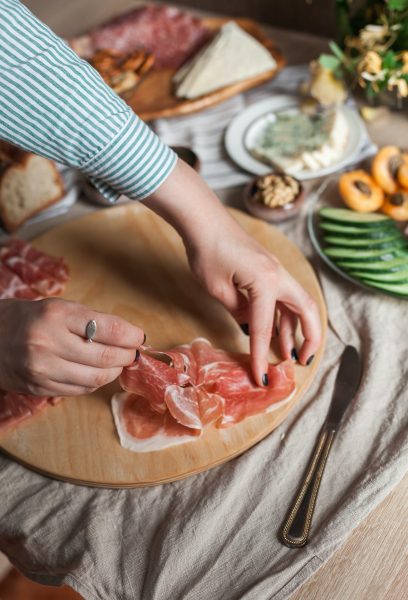
The Best Cheeses for a Charcuterie Board
Cheese is the perfect complement to the cured meats on your board. Aim for a diverse selection with contrasting textures and flavors. Here are some cheese categories to choose from:
Soft Cheeses: Indulge in the creamy goodness of Brie, Camembert, triple-cream, burrata, goat cheese, fresh ricotta, and Gorgonzola dolce. These spreadable delights offer a burst of flavor and a luscious, buttery texture. No need to commit to a whole wheel; a simple slice will do wonders. Imagine savoring an oozy Brie drizzled with honey and accompanied by a slice of speck – pure heaven!
Semi-Soft Cheeses: Meet the perfect balance between soft and firm with cheeses like Drunken goat, fontina, Muenster, Roquefort, and Havarti. These gems are easy to slice and arrange on your charcuterie board. They boast a creamy consistency without being overly gooey, and their mild yet distinct flavors add depth to the board. Picture pairing Fontina with a thick slice of spicy salami for a delightful harmony of tastes.
Firm Cheeses: Step up your charcuterie game with Cheddar, Gouda, Gruyère, Stilton, Jarlsberg, and Manchego. These cheeses are bold enough to stand their ground in terms of flavor. Their firmness allows you to effortlessly top your crackers or bread and enjoy them with your favorite cured meats. The firm cheeses bring a touch of funk and rich taste, with Grassy Gruyère elevating the salty prosciutto to new heights.
Hard Cheeses: Experience the savory allure of Parmigiano-Reggiano, Pecorino-Romano, Asiago, and Mimolette. These cheeses are dry, salty, and slightly crystallized, making them perfect for breaking into delightful chunks or pre-slicing for easy serving. They complement fatty cuts like soppressata or bresaola, creating a harmonious balance of flavors on your charcuterie board.
Remember that cheese is usually sliced thicker than meat, both by the store and your guests. So be generous when selecting your cheeses. You can pick one cheese from each category, but feel free to customize your board with fewer than four cheeses. Whether you choose two or four, you’ll have plenty of space to showcase other delights like bread, grapes, and other extras. So get creative and create a cheese paradise that suits your taste!
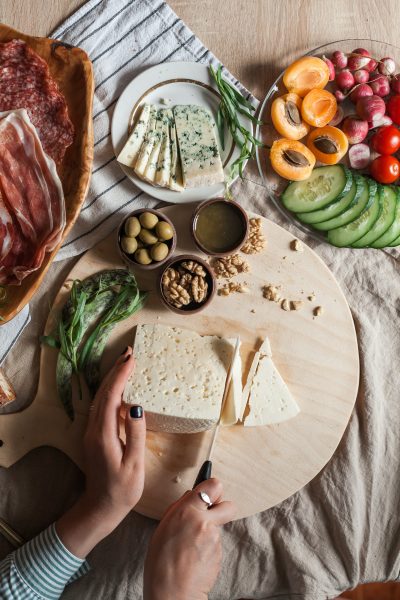
Bites for Stacking and Spreading
To enhance the flavors and experience of your charcuterie board, provide your guests with something to stack and spread their bites on. Here are some excellent options to consider:
Bread: Get ready to elevate your charcuterie board with a variety of bread options! Consider trying a classic baguette, toast points, flatbreads, Melba toast, crostini, or toasted pita. For a rustic touch, tear a baguette into chunks with craggy edges, perfect for pairing with oozy cheese and delectable spreads. And here’s a nifty trick to make your baguette taste freshly baked and warm: spritz it with a tiny bit of water, then pop it in the oven at 350 degrees F for 5-10 minutes. You’ll be left with a delightful crispness on the outside and a warm, inviting inside!
Crackers and Crisps: The world of crackers and crisps offers endless possibilities, including gluten-free options. Don’t underestimate the power of a plain water cracker or the classic saltine – they can be surprisingly satisfying! For some extra flair, consider adding fruit and nut crisps to the mix. Feeling adventurous? Throw in some homemade favorites like cheese straws or go for a seedy option with these crackers.
Fresh Vegetables: Add a refreshing crunch and a burst of color to your board with an array of fresh vegetables. Broccoli, bell peppers, celery, carrots, and radishes are just a few of the many veggies that will happily join your party. For a delightful combination, try pairing a crisp red bell pepper with creamy muenster cheese and a hint of salami – a tantalizing taste experience awaits!
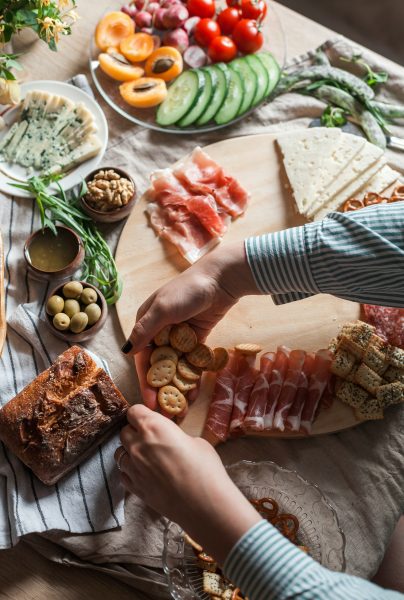
And Don’t Forget the Extras
To elevate your charcuterie board to the next level, don’t skimp on the extras. These fillers add visual appeal, balance the flavors, and keep your guests nibbling happily. Here are some delicious extras to include:
Nuts: For a delightful crunch and burst of flavor, consider adding a variety of nuts to your charcuterie board. Spiced nuts, candied nuts, Marcona almonds, roasted nuts, and nut brittle all make fantastic choices. You can easily whip up some quick spiced nuts or pick up some candied nuts from the store. If you prefer simplicity, plain roasted nuts are still wonderful additions.
Fruit: Don’t forget to include a selection of delectable fruits on your board. Grapes, sliced apples, and pears, as well as dried apricots, dried cranberries, and both dried and fresh figs, bring a burst of sweetness and balance to the savory goodness. Apples are particularly versatile and make for a great cracker substitute in many combinations. Grapes are a crowd-pleaser for a reason – they stay fresh at room temperature and perfectly complement the meat and cheese flavors. And let’s not overlook the beauty of seasonal fruits; in late summer, peaches and melons are a revelation when paired with prosciutto and brie!
Spreads: Get creative with a range of delightful spreads to tantalize your taste buds. Honey, mustard, fig jam, membrillo (quince paste), pepper jelly, sweet or savory chutneys, and tapenades all add exciting flavor combos to the mix. One of my personal favorites is adding a pinch of red pepper flakes to honey for a sweet and spicy spread that pairs brilliantly with almost every meat and cheese.
Pickled/Briny: To create a delightful contrast to the richer flavors, include a selection of pickled and briny treats. Brined or oil-cured olives, cornichons, caper berries, marinated artichokes, roasted red peppers, and pickled vegetables add a refreshing tanginess. You can draw inspiration from the Italian antipasto by including artichokes and red peppers, or embrace a touch of southern style with bread and butter pickles and pickled okra. These additions will take your charcuterie board to the next level!
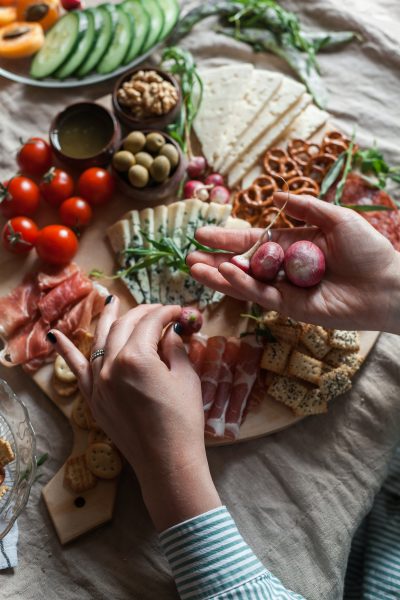
How to Assemble Your Charcuterie Board
Now that you have all the elements for your charcuterie board, it’s time to assemble it. Here’s a step-by-step guide to create a visually stunning and delicious masterpiece:
The Ideal Board
For the ultimate charcuterie board, you’ll need a sturdy foundation. Choose wood, marble, slate, or ceramic boards. Ensure it’s food-safe with a label confirmation. We suggest a board that is 18×24 inches to 20×30 for serving 8 to 10 people. For a charcuterie board to feed 4 to 6 people, a suitable size range would be approximately 12×18 inches to 16×20 inches. Get creative and arrange meats and cheeses on one board, surrounding bowls or plates for crackers and breads. Let particularly strong cheeses shine on their own plate. A tiered platter adds elegance. Remember, there’s no wrong answer—have fun creating a delightful board for your guests!
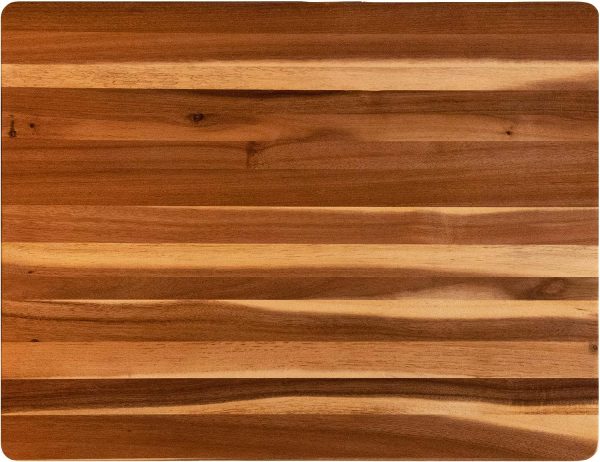
Containers
Opt for cute jars and bowls to elevate your charcuterie board’s style. Before you hit the shops, check your home inventory for hidden gems. Keep an eye out for nice containers in your everyday life that can be repurposed. Those little jam jars and fun vessels will be perfect for holding honey and other spreads, creating an eclectic and charming look. Aim for jars and bowls that are not too tall or wide, ensuring that all the food is at the same level and easily accessible. And here’s a quirky tip: I love using clean baby food jars—they’re the perfect height! Before using them, soak your glass jars in hot, soapy water overnight to easily remove any labels.
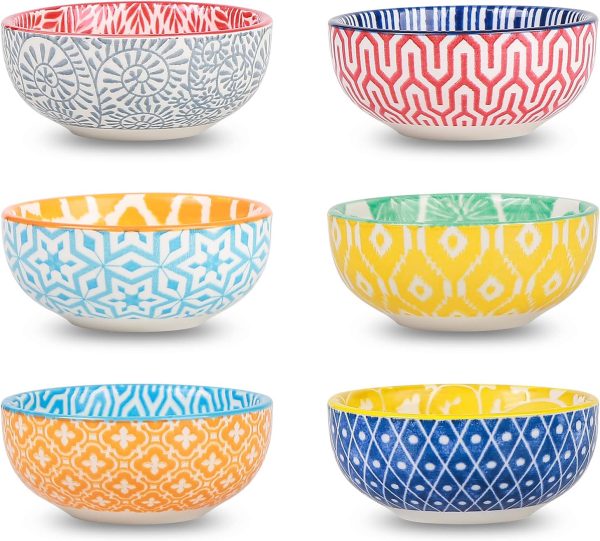
Utensils
Discover unconventional utensils for your charcuterie board. Look for little spoons, forks, and knives at flea markets or garage sales—demitasse spoons are perfect. Don’t worry about them being silver; any small utensils will do. Alternatively, explore the niche market for cheese knives and charcuterie tools designed for this purpose. Standard forks, knives, spoons, and toothpicks work fine too. Essentials include sharp knives for hard cheeses, spreading knives for softer ones and spreads, and spoons for honey. Forks or picks come in handy for extras like pickles. You don’t need a utensil for each item, but a few forks and knives can avoid mixing flavors.
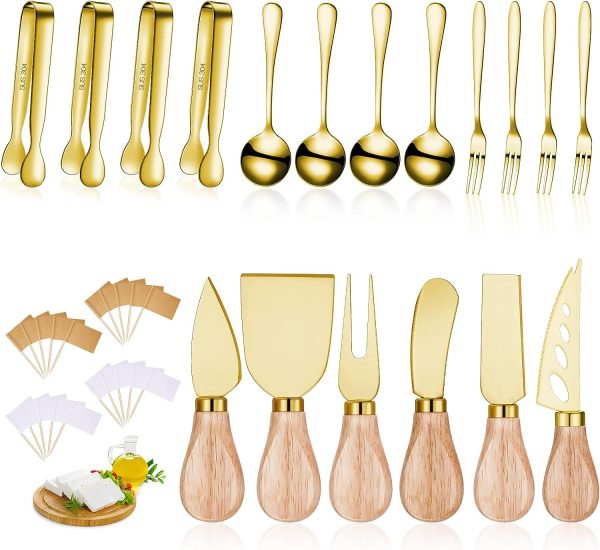
Simple All-In-One Solutions
If you’re seeking a budget-friendly, hassle-free option, check out these ready-to-go, smaller charcuterie sets. They offer a quick and easy solution without breaking the bank.
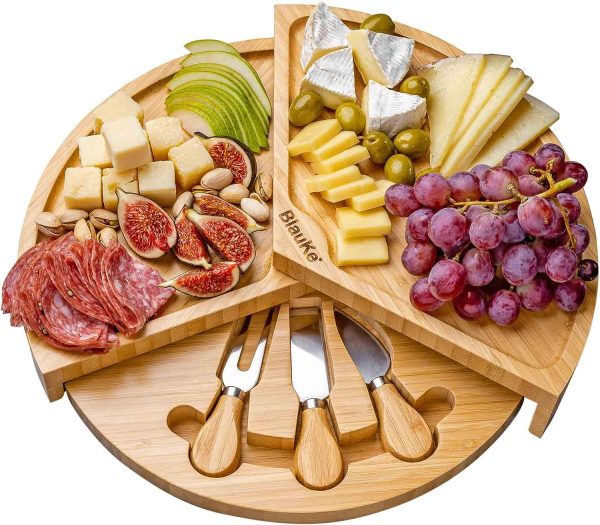
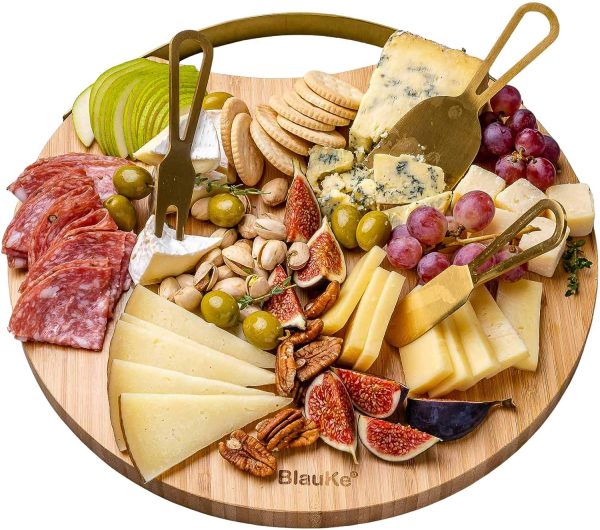
Time to Build the Perfect Charcuterie Board
Gather your tools and ingredients, it’s time to build the charcuterie board! First, lay out your meats. Arrange them creatively, like rolling slices into rose-like shapes or making clumps and swirls of cured hams. Show off their textures and make them easy to grab.
Next, place the cheeses near their perfect meat pairings, and play with angles to add flair. For hard cheeses, opt for slices or crumbles for easier serving. For firm/semi-soft cheeses, include both a hunk and pre-sliced portions. Leave soft cheeses whole, but show everyone they’re up for grabs by taking out a small piece.
Now, nestle in the jars of spreads strategically. Place spiced honey near Parm, bresaola, and Brie, and mustard close to ham and Gruyere. Add pickled vegetables as well.
Let’s not forget the extras! Fill empty spaces with fruits, nuts, and vegetables. Mix and match to add color and variety.
Lastly, bring in the bread. Arrange crackers or crostini like a vein through the board, and feel free to get creative with stacks or vertical displays.
Remember, more is more, so don’t hesitate to go all out with the extras and HAVE FUN making a charcuterie board that is uniquely yours!